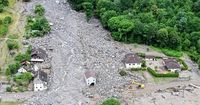Relentless monsoon rains have unleashed a wave of devastation across Nepal and parts of neighboring India, with landslides and flash floods claiming more than 60 lives and leaving many communities cut off from aid. The disaster struck suddenly on Friday, October 3, 2025, as torrential downpours battered the Himalayan region, overwhelming rivers, destroying infrastructure, and putting rescue teams under intense pressure.
According to The Kathmandu Post and AFP, Nepal has borne the brunt of the catastrophe. At least 47 people have been killed in Nepal alone, with the eastern district of Ilam (also spelled Illam) suffering the highest toll—35 to 37 deaths attributed to separate landslides. In addition to the fatalities, nine people remained missing after being swept away by floodwaters, and three others were killed by lightning strikes elsewhere in the country, as confirmed by Kalidas Dhauboji, a spokesperson for the Armed Police Force.
"Rescue efforts for the missing persons are going on," said Shanti Mahat, spokesperson for Nepal's National Disaster Risk Reduction and Management Authority, speaking to AFP. She added that at least 43 people had died in rain-triggered disasters, with five still unaccounted for by Sunday.
The scale of the destruction has been staggering. Major transport arteries into Kathmandu, Nepal’s capital, have been rendered impassable by landslides. The Araniko Highway, a crucial route linking Kathmandu to the Chinese border, collapsed at several points, while the BP Highway connecting eastern regions was buried under debris. Domestic flights were suspended on Saturday, October 4, due to poor visibility, leaving hundreds of travelers—many returning from the Hindu festival of Dashain—stranded. International flights continued, though with some disruptions, as confirmed by Rinji Sherpa, spokesperson for Kathmandu airport.
The timing of the disaster has only compounded its impact. The downpours hit just as hundreds of thousands of Nepalis were making their way back to urban centers after Dashain, the country’s most significant religious festival. Thursday marked the festival’s main day, when families traditionally gather in their ancestral villages. The sudden floods and landslides left many unable to return home or stranded en route, with blocked highways and flooded settlements exacerbating the crisis.
In Kathmandu itself, rivers swelled alarmingly, inundating low-lying settlements along their banks. Security personnel, including police and military, were deployed with helicopters and motorboats to assist in rescue operations and evacuate residents from the worst-hit areas. Vegetable seller Rajan Khadga, 38, told AFP, "There is some damage, but thanks to the authorities' prior flood alert, we were able to move some belongings to a safe place."
The government responded with urgency. The Ministry of Home Affairs declared nationwide public holidays on Monday and Tuesday (October 6 and 7), exempting only emergency services and disaster response teams. Government spokesperson Rameshwar Dangal cited forecasts of continued heavy rains as the reason for this extraordinary measure. Prime Minister Sushila Karki reassured the nation in a televised address, stating, "Your safety is our utmost concern. Do not hesitate to seek necessary assistance." She urged citizens not to travel unless absolutely necessary during the ongoing emergency.
More than a dozen districts, including major population centers and parts of Kathmandu, were placed on red alert by meteorological authorities. Kamal Ram Joshi, chief of the Meteorological Department, warned residents near waterways to evacuate immediately, as reported by The Kathmandu Post. The provinces of Bagmati, Gandaki, Lumbini, and Madhesh were expected to bear the brunt of the continuing downpours through Monday morning.
Of particular concern was the Koshi River in southeastern Nepal. Local official Dharmendra Kumar Mishra confirmed that water levels had surged to more than twice their normal volume, prompting authorities to open all 56 sluice gates at the Koshi Barrage—far more than the usual 10 to 12. Officials considered restricting heavy vehicles from crossing the bridge, fearing further structural damage. The Koshi River, notorious for causing catastrophic flooding in India’s Bihar state during the monsoon, continues to pose a serious threat downstream.
The disaster did not respect borders. In India’s Darjeeling district, nestled in the tea-growing hills of West Bengal, at least 20 people lost their lives after heavy overnight rain triggered landslides and flash floods. Abhishek Roy, a Darjeeling district police official, told Reuters, "Seven dead bodies have already been recovered from the debris. We have information about two more people. Work is being done to recover their bodies too." Indian Prime Minister Narendra Modi expressed his condolences and concern, stating, "The situation in Darjeeling and surrounding areas is being closely monitored in the wake of heavy rains and landslides." Harsh Vardhan Shringla, a lawmaker from the region, confirmed the scale of the devastation, describing the previous night’s storm as a "heavy cyclone."
Footage broadcast on Indian television showed rescue workers using cables to access isolated communities, as raging waters destroyed bridges and caved in roads. With many areas difficult to reach, some rescue teams had to travel on foot, as local district official Sunita Nepal explained: "With roads blocked, some areas are difficult to reach. Rescue workers are heading there on foot."
Landslides and flash floods are a grimly familiar hazard in Nepal and northern India during the monsoon season, which typically runs from June to September. Each year, hundreds perish as the mountains yield to rain-soaked earth. Yet, as experts have repeatedly warned, the frequency and intensity of such disasters are on the rise. The Kathmandu-based International Center for Integrated Mountain Development sounded the alarm in June, cautioning that "rising temperatures and more extreme rain raise the risk of water-induced disasters such as floods, landslides, and debris flows." Many scientists and disaster management officials now link the worsening toll to climate change, which has intensified the monsoon’s unpredictability and destructive power across South Asia.
For now, with the rains only just beginning to subside, the focus remains on rescue and relief. Security personnel continue to search for the missing, clear debris, and deliver aid to stranded communities. As the region grapples with the aftermath of yet another deadly monsoon, questions about preparedness, infrastructure resilience, and the looming threat of climate change are sure to dominate public debate in the weeks ahead.
In a country where natural disasters are a tragic part of life, the people of Nepal and northern India once again find themselves coming together in the face of adversity, relying on resilience, community, and the hope that next year’s monsoon might be kinder.




